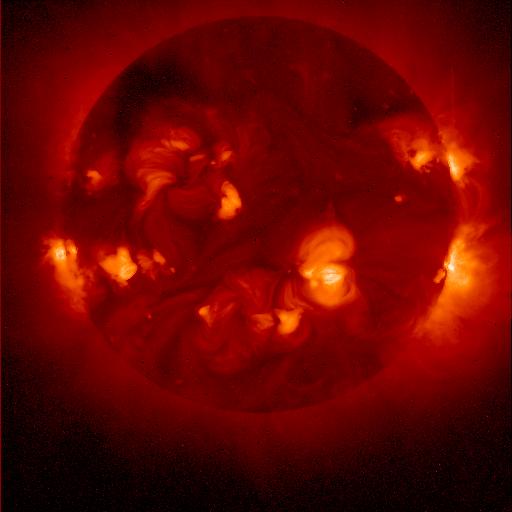
 Credit: ISAS/Yohkoh team/Lockheed Palo Alto Research Laboratory
Credit: ISAS/Yohkoh team/Lockheed Palo Alto Research Laboratory
Soft X-ray emission from the Sun
The outer part of the Sun's atmosphere is a churning cauldron of hot gas,
heated by magnetic processes which originate in the solar interior. The
gas in the outermost part of the solar atmosphere (the solar "corona") gets
heated to millions of degrees, and is an abundant source of soft X-rays.
The X-ray emission from the solar corona is a measure of the amount of heat
in the outer solar atmosphere, and a measure of the magnetic activity in
the sun's interior. The image above shows the soft X-ray emission from the
solar corona; dark regions are regions of little X-ray emission, while
brighter regions show parts of the sun where X-ray production is abundant.
Note that the emission is not uniform around the sun, and that a large
fraction of the bright emission is in the form of "loops" anchored in the
solar surface and extending into space. The image above was obtained on
November 23, 1999 by the Soft X-ray Telescope, on
board the Japanese satellite Yohkoh ("sunbeam") . The Yohkoh
mission is a Japanese solar observatory (with US and UK participation)
which was launched on August 31, 1991. Yohkoh is designed to answer many
questions about the physics of the solar corona and solar flares. The
Japanese Institute for Space and
Astronautical Sciences (ISAS) provides overall program management, the
launch vehicle, the mission instruments, and a Wide Band
Spectrometer. The Soft X-ray Telescope was designed by the Lockheed
Palo Alto Research Laboratory, under NASA support, in collaboration with
the National Astronomical Observatory of Japan and the University of Tokyo.
Yohkoh has become a vital tool for observing and attempting to understand
solar flares.
Last Week *
HEA Dictionary * Archive
* Search HEAPOW
* Education
Each week the HEASARC
brings you new, exciting and beautiful images from X-ray and Gamma ray
astronomy. Check back each week and be sure to check out the HEAPOW archive!
Page Author: Dr. Michael F.
Corcoran
Last modified February 15, 2002


